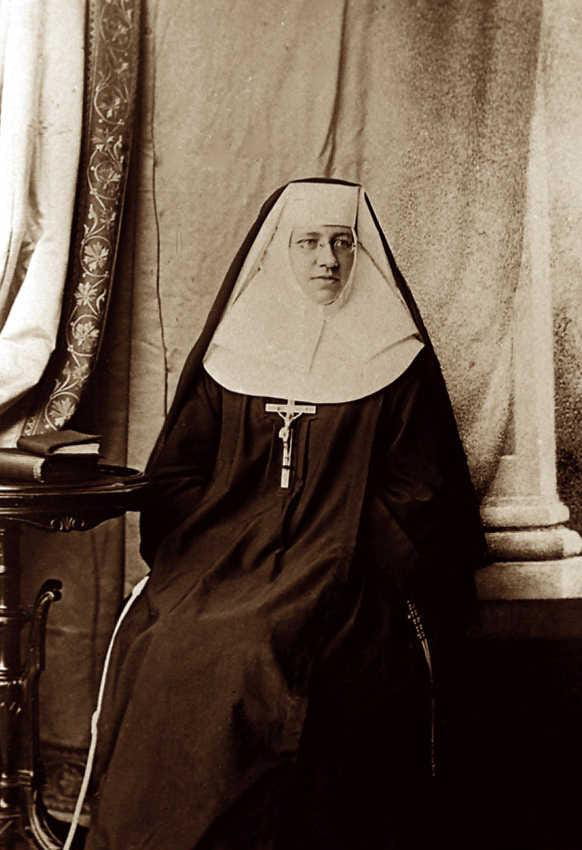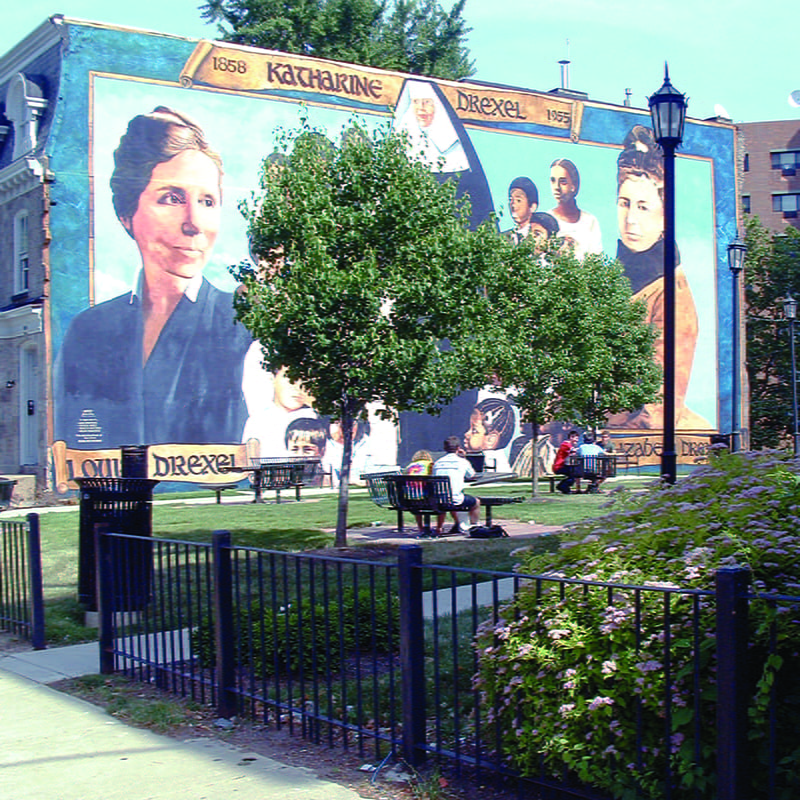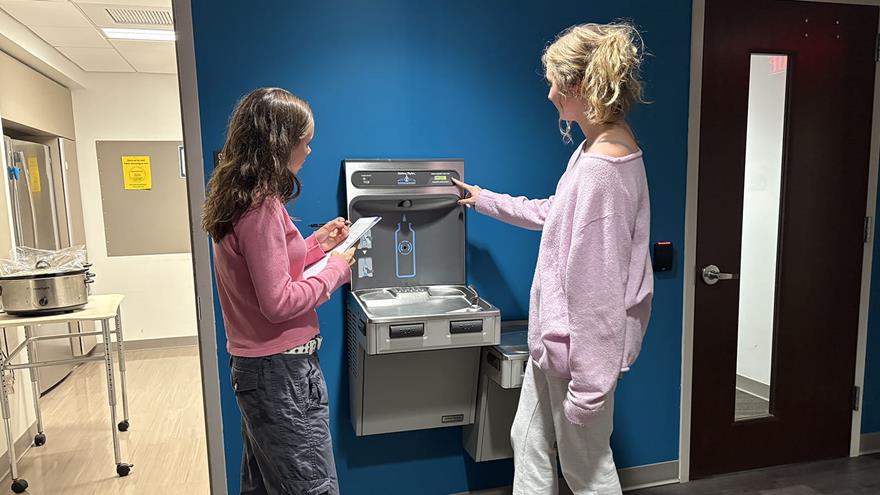Sacred Remains of Saint Katharine Drexel Installed in Philadelphia

The sacred remains of Saint Katharine Drexel (1858–1955), a member of the Drexel family dynasty who gave up a life of luxury to dedicate herself to the Roman Catholic Church, were brought back to her hometown of Philadelphia earlier this fall. Her life will be formally celebrated Nov. 18 at a ceremony at her new resting place at the Cathedral Basilica of Saints Peter and Paul, which had been attended by her family and where her funeral mass was held. Her tomb is located near the Drexel family altar that she and her two sisters donated in memory of their parents in the early 1880s.
Katharine, who is only the second American-born person to become a saint, was the beloved niece of Drexel founder Anthony J. Drexel. Members of the University community and the Drexel family are honoring her life and her work by attending the special mass held on Nov. 18 and/or attending a special University celebration on Nov. 17 that will also be attended by a delegation from Xavier University of Louisiana, which she founded in 1915 and is the only historically black college or university that is Catholic.
“Our institutions continue to advance the values championed by these two trailblazing members of the Drexel family,” said Drexel President John Fry. “We provide diverse teaching and learning environments that empower students to seize the professional opportunities of the future while leaning into societal challenges. Our graduates embrace leadership and service roles focused on improving lives and strengthening communities.”
The University has long celebrated its connection to Katharine. When she was canonized by Saint Pope John Paul II in 2000, Constantine Papadakis, who was then the president of the University, attended the celebration in Rome alongside 200 members of the Drexel family.
After her death in 1955, Katherine’s sacred remains were housed in a shrine at the motherhouse of the Catholic order she had founded in 1891. In 2016, the order, the Sisters of the Blessed Sacrament, announced the sale of the Bensalem property, and the Archdiocese of Philadelphia subsequently created a shrine for her in Philadelphia.
During her long life, Katharine created and supported schools for Native Americans and African Americans, spending an estimated $20 million and 60 years of her life building dozens of educational institutions as well as over 100 missions and churches. She shared the same enthusiasm for creating educational opportunities as her “Uncle Tony.”
“My understanding is that she and her uncle were close, perhaps even closer than he was to his own children. They had the same determination and sense that education was critical. Education, to them, was paramount,” said Cordelia Biddle, a local author and member of the Drexel family who wrote “Saint Katharine: The Life of Katharine Drexel” in 2014. She also teaches creative writing in the Pennoni Honors College, and this year will teach “Writing History” in the winter term and “Writing Killer Fiction” in the spring.

Biddle is the great-great-granddaughter of Katharine’s beloved cousin Emilie, who was the eldest daughter of the University founder. Biddle’s grandfather Livingston, Emilie’s son, was raised by him after Emilie’s death; Katharine and her older sister Elizabeth were sent to live with “Uncle Tony” for two years after her mother Hannah Langstroth died shortly after her birth in 1858.
The Drexel family was Catholic; Anthony J. Drexel left the Catholic Church when he married his Episcopalian wife Ellen in 1850. Katharine’s father Francis Anthony (Frank) Drexel remarried Emma Bouvier (a distant relative of Jacqueline Kennedy Onassis), a devout Roman Catholic, in 1860, which is when Katharine and her sister moved back with their father.
Both Emma and Frank instilled in Katharine and her two sisters (her younger sister Louise was born in 1863) the importance of charity work and Catholicism. Their home at 1503 Walnut St., which had a private chapel, was open to the public three times a week when Emma and the Drexel girls distributed medicine, clothing, blankets and even rent money to the poor, regardless of race or faith. Frank and his family traveled West to visit missions and Native American reservations, later building Catholic mission schools in the land from the Great Lakes to the Columbia River to the Mexican border.
When Frank died in 1885, his will stipulated that a tenth of his new residuary estate of about $15.5 million (about $387 million in 2018) be dispersed to 27 different institutions, including the Cathedral Basilica of Saints Peter and Paul. His daughters received the rest, becoming some of the country’s wealthiest heiresses. Katharine began seriously considering devoting herself to God’s work after the death of her father and her step-mother a few months before. Still, she was pressured by her family and her spiritual advisor, Bishop O’Connor, to instead continue with her charitable work, which she financed using her sizable family wealth and, later, her $7 million inheritance (worth about $180 million in 2018).
In 1887, during a private audience with Pope Leo XIII, Katharine asked him to send missionary priests to the Native Americans, for whom she’d been supporting and financing schools and missions for years. The Pope reportedly responded, “Why not my child, yourself become a missionary?”
For the next two years, Katharine considered this offhand remark, creating a pros and cons list about entering a convent while she continued her charitable work to promote underserved communities. In the spring of 1889, she had made her choice — and finally told her uncle.
“Uncle Anthony dropped four or five tears; but said he would not oppose anything which would contribute to my happiness,” she later wrote. “He thinks, however, that I am making the mistake of my life if I become a religious; yet he consents.”
That November, she entered the convent and became a postulant with the Sisters of Mercy in Pittsburgh. Anthony was among the family and friends who took a train to Pittsburgh for the ceremony. While pronouncing her vows in February of 1891, she established the Sisters of the Blessed Sacrament, an order of nuns dedicated to serving African Americans and Native Americans oppressed by discrimination and poverty.

As Katharine contemplated becoming a nun, her uncle was toying with the idea of opening an institution of higher education. In the late 1880s, he had planned to start a women’s industrial college in the Philadelphia suburbs, even purchasing an estate in Wayne for the school and announcing his intentions in 1888. But he feared that it was too close to Bryn Mawr College (a women’s college that opened in 1885) and too far removed from an urban setting. Another possible reason for the change of heart could have been his niece.
Instead, he ended up creating the Drexel Institute of Art, Science and Industry, which was founded in 1891 and welcomed students of any gender, race, religion and class.
“How much Tony’s radical vision of his institute and Katharine’s radical vision of her order influenced each other is hard to say,” wrote Dan Rottenberg, author of “The Man Who Made Wall Street: Anthony J. Drexel and the Rise of Modern Finance.” “But both ideas moved forward at the same time — between 1889 and 1891 — and during this period uncle and niece remained in constant touch with each other.”
In her lifetime, Katharine developed a network of 145 Catholic missions as well as 12 schools for Native Americans and 50 schools for African Americans located throughout the American South and West. Every school was co-educational — something that Pope Pius XI denounced in a papal encyclical, or an official papal document concerning Catholic doctrine, in 1929. Though Katharine travelled to the Apostolic delegate in Washington, D.C., for diplomatic reasons after the encyclical was published, she continued to promote and believe in educational equality for all.
“For a woman to buck Rome was a big deal,” said Biddle. “By refusing to obey, she could have caused a firestorm.”
Katharine also stood up to Jim Crow laws and the Ku Klux Klan while battling the general public’s negative reactions toward women’s suffrage, African Americans and Native Americans. Her long life of social activism counted as part of her “heroic virtues” leading to her beatification in 1988. She was canonized 22 years later after two miracles involving healing deafness were ascribed to her.
For decades, her resting place in Bensalem was a shrine and place of pilgrimage for prayers of intercession to her. Now, her tomb has been moved to a central location in Philadelphia, where it can be more easily visited by people for prayers. The Connelly Foundation, which donates to local Catholic charities, provided funds for the construction of the tomb as well as new communications and an education program to promote Philadelphia’s homegrown saint.
“I hope that more people will be able to learn about this remarkable woman,” said Biddle. “We should hold Saint Katharine Drexel as an example of someone working tirelessly for social justice. She wrote, ‘Think it; Desire it; Speak it; Act it,’ which I believe sums up her determined life.”
In This Article
Drexel News is produced by
University Marketing and Communications.

